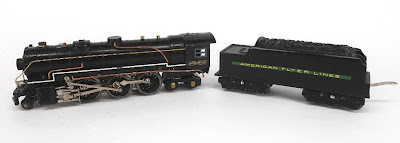Dad and I recently returned from our semi-annual trip to the Train Collectors Association (TCA) Eastern Division toy train meet in York, PA. This is the largest such show in the United States and provides an interesting snapshot of the state of the hobby.
It can also hint at the current state of collecting in general. As is our tradition, we spent a lot of time discussing what we saw a lot of (and what we didn't) -- and more importantly, the reasons behind them
From collector to operator
In
Part 1 I shared some examples of a hobby in flux. The first three generations of toy train collectors are selling more than their buying. There is a fourth generation, though. But this middle-aged group is made up of operators rather than collectors.
Yes, they're interested in the larger gauge trains that were the mainstay of Lionel and American Flyer. But they prefer to
run trains on a layout rather than display them on shelves.
Trains made by Lionel, MTH, Atlas, Bachmann, and others for today's market are much more reliable that fragile and finicky vintage equipment that's a half-century old.
And that change was readily apparent at the meet.
Code Orange
The York meet had six dealer halls, designated by color. Four were for members who sell vintage toys (that being a loose definition). Two -- the Orange and Purple Halls -- were reserved for manufacturers of new products.
In these two halls were the latest offerings from Lionel, MTH, et al. There were also plenty of offerings from smaller companies that specialize in operating layout accessories; scenery, benchwork, electronics; structures, etc.
 |
The Lionel booth in the Orange Hall. It didn't look like this in
the members-only halls. |
The Orange and Purple Halls were packed (at least while we were there). TCA allowed the general public into these two halls during the weekend. They did so at the last meet, and it was successful enough to continue this time as well.
Let's make a deal!
By contrast, the members-only halls weren't nearly as busy. These halls had the train items of interest primarily to the first three generations of collectors. There were many empty tables in these halls.
In the past, I had run across vendors who were anxious to close the deal. If I stopped to look at something, the table holder would appear at my side. He'd extoll the virtues of the object, and give me every reason why I should buy it right that minute!
And if I still resisted, he'd sometimes hint that the price was negotiable.
This time, it seemed that more of the vendors were like That Guy. Plus, I saw several signs at tables: "Prices negotiable" "Make me an offer" and so on.
I ran across a table with a pile of MPC Lionel boxes -- $10 each. Normally these would be in the $20-30 range, but not that day. The other half of the table was marked 50% off.
 |
My two York purchases. I was really only interested in the red
Southern box car from Lionel MPC. But for $10 each, I couldn't resist. |
To me, this suggests that the vendors also know the market is changing. And they want to get rid of their stock while there's still a window of opportunity to sell it. Because once the third generation stops buying, demand will plummet.
The October, 2018 meet should show if my impressions were correct.
One more thing
For the first time ever, I didn't see a Lionel Lifesavers Tank Car. Not one. It's been one of the few items I could count on spotting every meet. Have they all finally found homes?






































